Just enough kernel to get by (part 2) : Syscall & SSDT
Last week we detailed the interrupt dispatch internals, today we will focus on the syscall mechanism.
System overview
The diagram below shows a very high level and simplified view of the Windows architecture (I have omitted subsystem and GDI stuff to keep it simple)
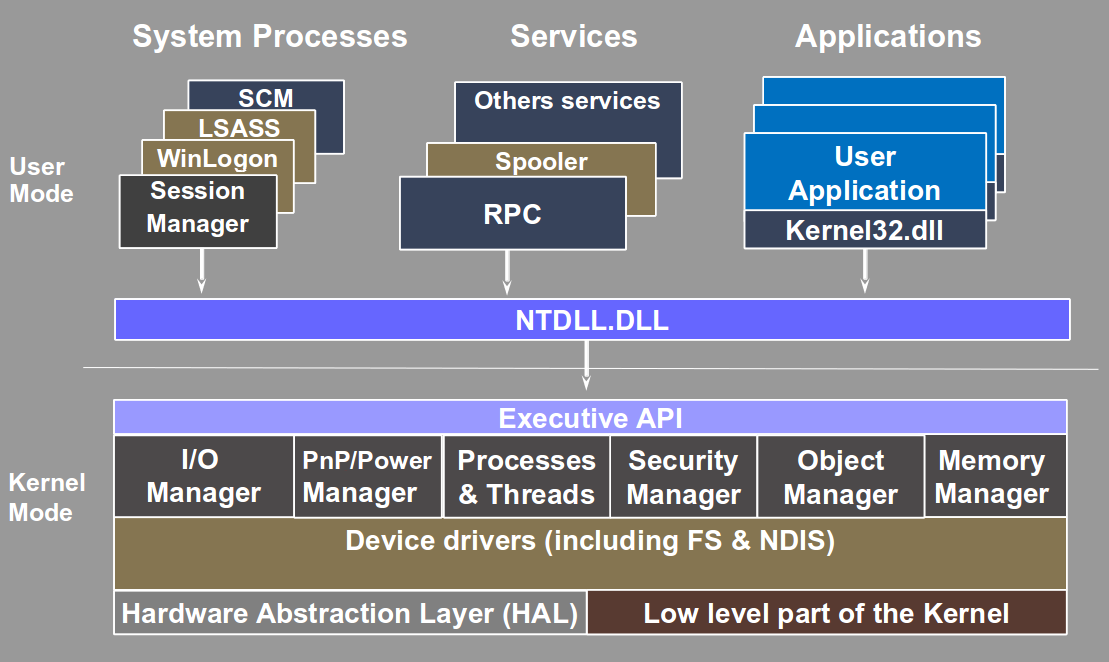
So basically there are 3 families of processes running :
- System processes like smss.exe, lsass.exe, winlogon.exe etc…
- Services ranging from system services (DHCP, RPC etc …) to third party services (AVs, SGBD etc …)
- Applications (Word, Notepad, Firefox,…)
During the life of processes lots of API calls will end up in the kernel to be serviced, and except for the GDI/Windowing stuff, this will be ntdll.dll role to perform the syscall and make the transition from user land to kernel.
So basically, when you call CreateFile from your application it will go through kernel32.dll to end up in ntdll.dll in the ZwCreateFile function.
Depending on the CPU, ZwCreateFile will issue the system call using either :
- INT 2E software interrupt (old CPUs)
- SYSCALL (AMD) or SYSENTER (Intel) instructions
In the first scenario, the 2E interrupt will be serviced by the KiSystemService ISR :
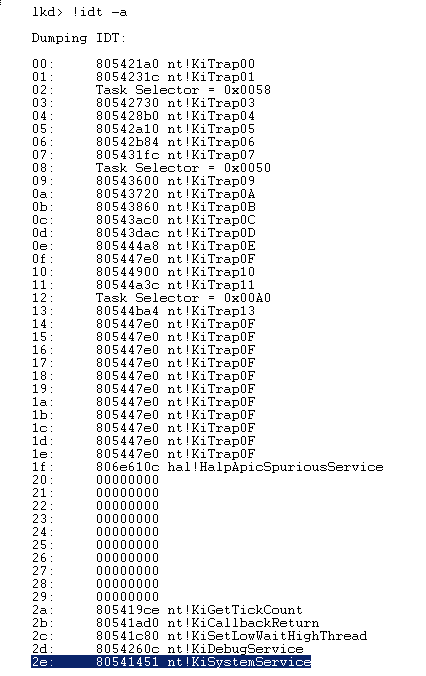
Then KiSystemService will call KiFastCallEntry which will call the kernel implementation of ZwCreateFile :
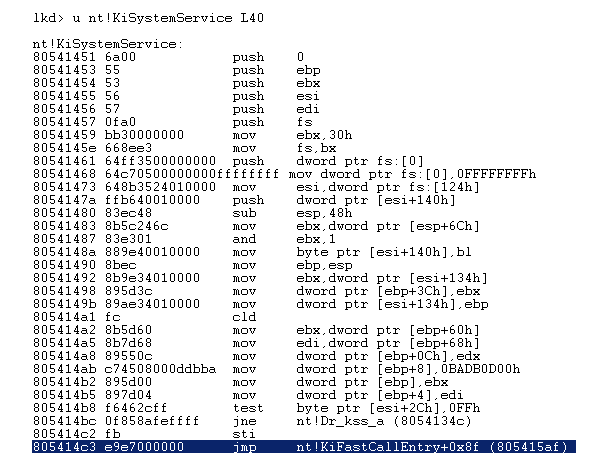
But how does KiFastCallEntry know which function to call in the kernel ?
Let’s take a closer look at the second scenario from the beginning and detail it step by step (as it is the most common scenario you will face on today’s machines)
Nowdays rather than using the INT 2E mechanism the OSes use the SYSCALL / SYSENTER instructions to perform the system call.
These instructions were introduced to speed up the user to kernel mode transition as using the software interrupt mechanism was to slow (There is LOTS of user to kernel switches going on every seconds).
So let’s go back to the implementation of ZwCreateFile in ntdll.dl :

First thing it does is to put 0x25 in the EAX register (remenber this) and then call a function pointer, so let’s follow this pointer :

and again, we end up in KiFastSystemCall :

And here is the real stuff, the SYSENTER call.
Once this instruction is executed, the CPU will switch from user land to kernel mode. But how does the CPU know which kernel function to call when entering kernel mode ?
The answer lies in the MSR registers (Model-Specific Register).
These registers are kind of special since you do not access them directly but through 2 dedicated instructions RDMSR (read) and WRMSR (write).
There is plenty of MSR registers (will get back to some of them in due time), but the one we are interested in right now is SYSENTER__EIP__MSR (Offset 0x176).
This register tells the CPU which OS kernel function to call while handling a SYSENTER .
So let’s dump it in Windbg :
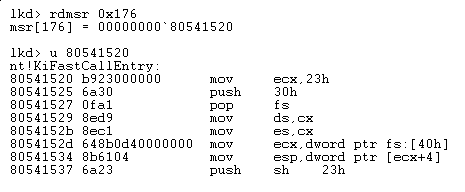
Aaahhh what a surprised, we find the KiFastCallEntry function, yep the same one called in the KiSystemService function we saw previously while describing the good old INT 2E mechanism.
So, now we know that regardless the scenario used to perform the system call we will end up in KiFastCallEntry.
But how does this function know which kernel function to call ? Meaning, what is the kernel land equivalent of the API we were calling in our application (in our case CreateFile)?
The answer lies in the KiServiceTable also known as the SSDT (System Service Descriptor Table).
This is basically an array of functions pointers where each function referenced is the kernel implementation of the Nt* functions stubs in ntdll.dll.
So let’s dump it (just a part of it) in Windbg :
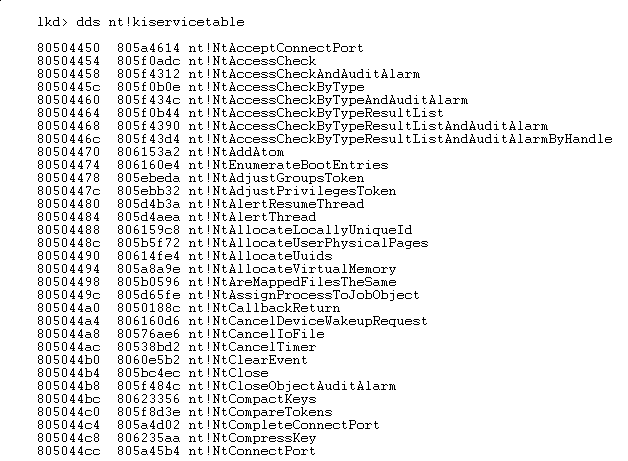
This is it, most of the user mode APIs you will ever call from your application (except GDI stuff) will end up here…
At runtime KiServiceTable is not exported, but you can use the kernel export KeServiceDescriptorTable to access it, we will get back to this later…
So remember the 0x25 i mentioned while talking about ZwCreateFile ?
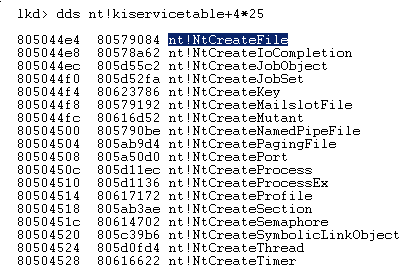
Circle is complete :)
Here is a summary of the User to Kernel mode transition mechanism :
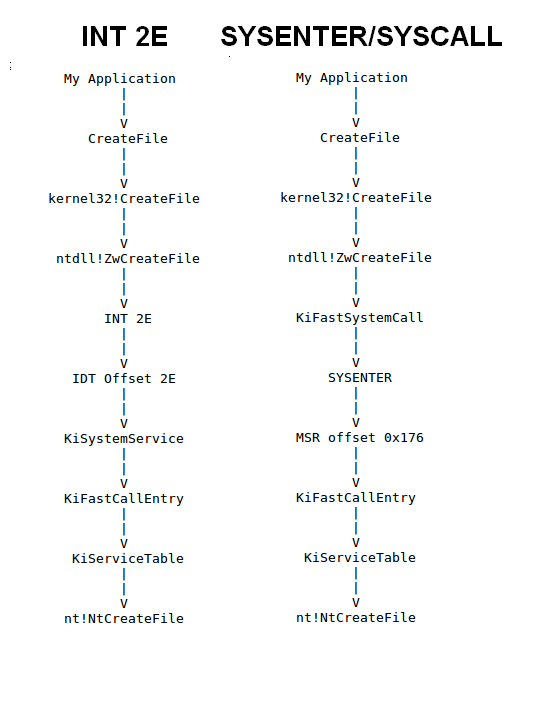
We will get back to the IDT / SSDT / MSR stuff later while talking about rootkits, because as you can imagine, those are perfect spots to perform some API hooking at kernel level :)
In the next post i will start describing some kernel object structures and will talk about the Object Manager.